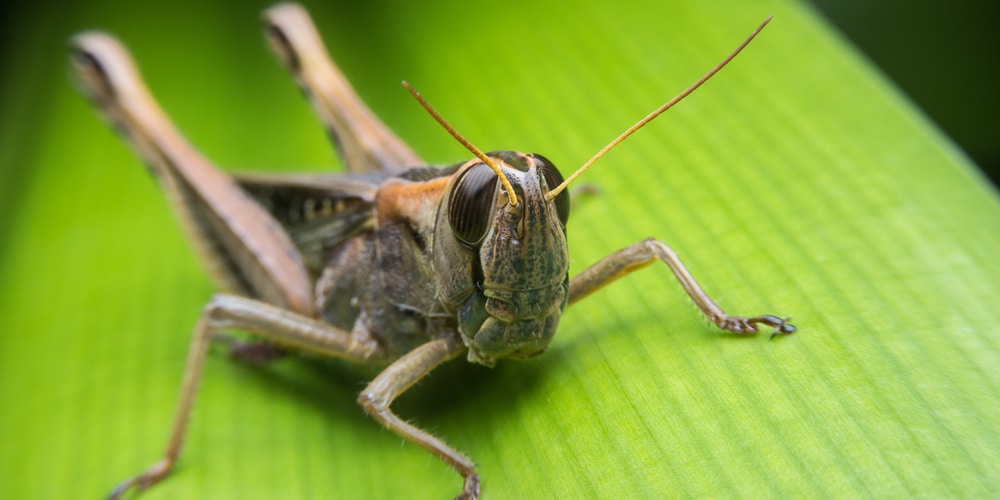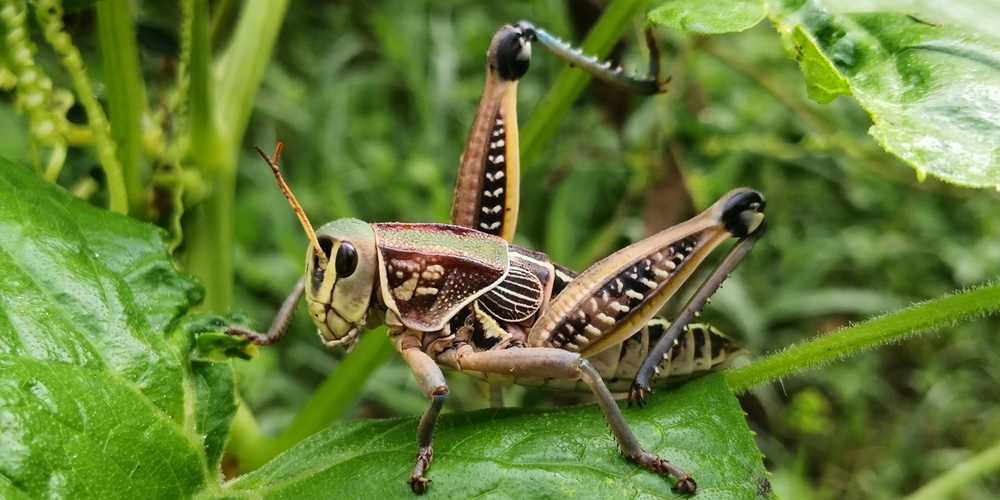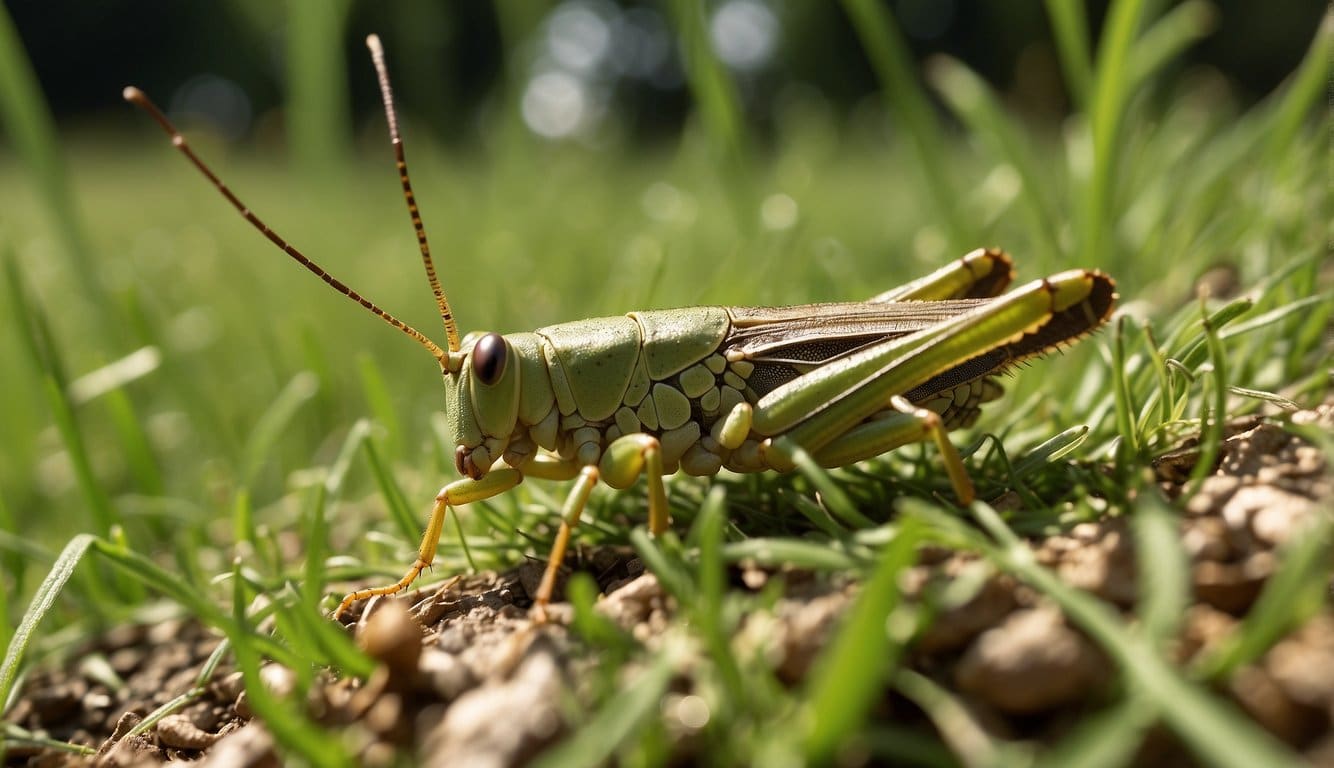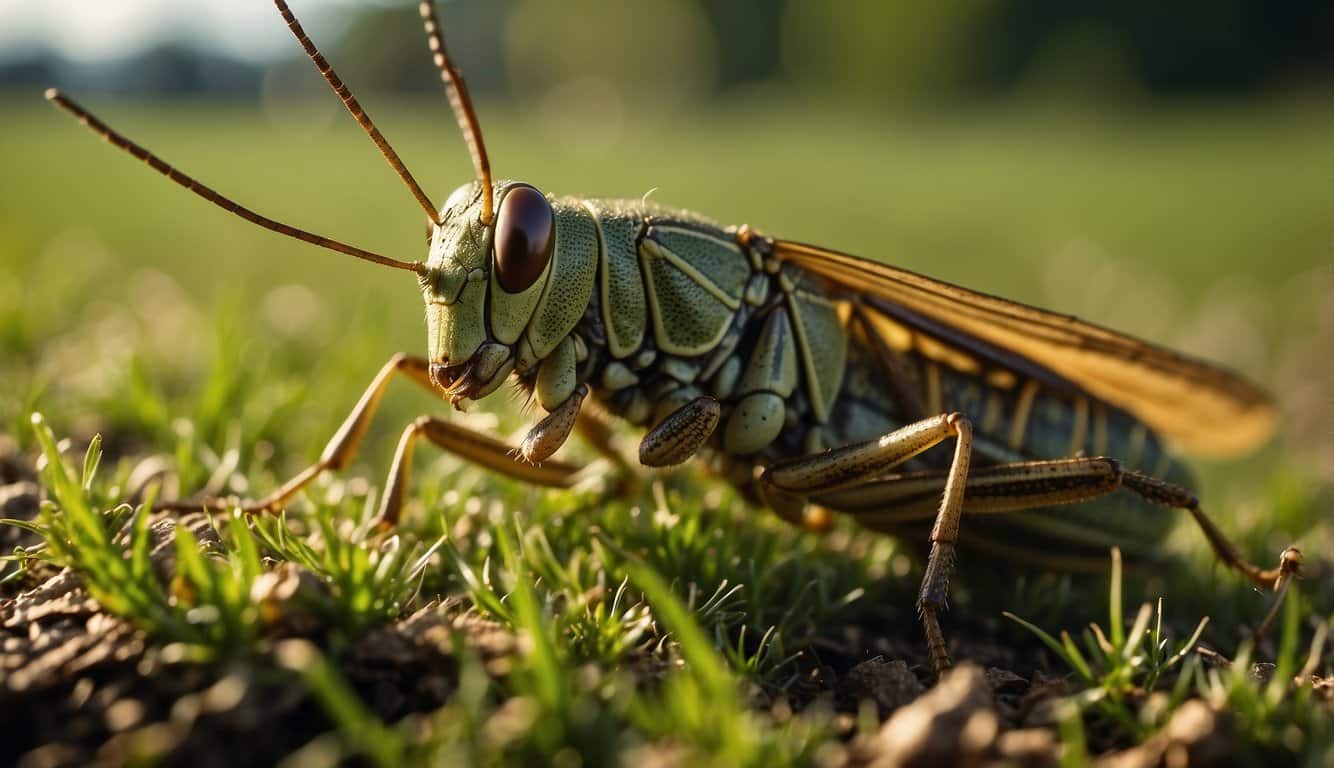The “Short Version”
| Question | How to Kill Grasshoppers in the Lawn? |
|---|---|
| Answer | Use a combination of cultural controls, physical barriers, natural predators, organic insecticides, chemical insecticides, and biological controls like Nosema locustae. |
| How to Get ‘Em Gone |
|

To manage grasshopper populations in your lawn, consider a combination of methods for effective control:
- Cultural Controls: Maintain a healthy lawn through proper mowing, watering, and fertilization to reduce grasshopper damage. Removing weeds and debris can also eliminate their hiding and breeding spots.
- Physical Barriers: Use floating row covers on garden beds to physically block grasshoppers from reaching plants.
- Natural Predators: Encourage the presence of natural predators like birds, frogs, and beneficial insects, which can help reduce grasshopper numbers.
- Organic Insecticides: Neem oil and insecticidal soaps can deter grasshoppers when applied to affected plants. These solutions are less harmful to beneficial insects.
- Chemical Insecticides: For severe infestations, chemical insecticides may be necessary. Products containing carbaryl, bifenthrin, or permethrin can be effective but use them as a last resort due to their impact on beneficial insects and the environment. Always follow the product’s label instructions carefully.
- Nosema locustae: This is a biological control method that targets grasshoppers specifically. It’s a naturally occurring microsporidian that infects and kills grasshoppers, available in some bait formulations.
Grasshopper Infestations: Why They Happen
An increase in grasshopper activity can signal a potential risk to lawn health.
This necessitates a deep dive into their life cycle, the factors contributing to population growth, and the subsequent impact on lawns.
Grasshopper Life Cycle
Grasshoppers go through a three-stage life cycle: egg, nymph, and adult.
The eggs are typically laid in the soil during late summer and hatch in spring. The nymphs resemble small adults and molt several times as they grow. Adults can be recognized by their ability to fly, which aids in their spread across lawns and gardens.
Reasons for Grasshopper Population Growth
The growth of grasshopper populations is often attributed to:
- Warm, dry weather: These conditions accelerate grasshopper development and increase survival rates.
- Abundant food supply: Overgrown vegetation and weeds offer ample food, leading to population booms.
- Predator absence: Lack of natural predators due to various environmental changes can reduce mortality rates among grasshoppers.
Impact of Grasshoppers on Lawn Health
Grasshoppers feed on a variety of plants, including grass, which can lead to:
- Visual damage: Large numbers of feeding grasshoppers can strip foliage, affecting a lawn’s appearance.
- Stunted growth: Heavy feeding by grasshoppers can stunt the growth of new grass, inhibiting lawn recovery.
Grasshopper Control Methods
Effective control of grasshoppers involves a combination of tactics that target different stages of their lifecycle and exploit their vulnerabilities.
Readers interested in maintaining the health of their lawns and gardens can choose from natural predators, organic solutions, or cultural strategies tailored to their specific situation.
Natural Predators and Biological Control
Natural predators like birds, rodents, and insects such as praying mantises can help control grasshopper populations.
The introduction of beneficial nematodes to soil targets grasshopper nymphs effectively, while certain fungal pathogens, used as biological insecticides, can infect and reduce grasshopper numbers without harming non-target species.
Organic and Chemical Pesticides
For those seeking a more immediate solution, organic options like neem oil can repel and control grasshopper infestations when mixed with water and a mild soap.
Chemical pesticides should be used as a last resort due to potential environmental impacts.
Always select insecticides labeled for grasshopper control and follow label directions carefully for the safety of other wildlife and humans.
- Organic Sprays:
- Neem oil
- Garlic spray
- Chemical Options:
- Bifenthrin
- Permethrin
Cultural and Mechanical Control Practices
Adjusting cultural practices can make an environment less inviting to grasshoppers.
Plant selections such as dianthus and lilac are less palatable to grasshoppers and can serve as deterrents. Mechanical control includes tillage to disrupt the insect’s life cycle and barriers, such as floating row covers, to physically prevent grasshoppers from reaching plants.
- Plant Selections:
- Dianthus
- Lilac
- Forsythia
- Mechanical Barriers:
- Row covers
- Screened enclosures
Environmental Considerations of Grasshopper Management
When addressing grasshopper populations, it is imperative to balance effective control methods with environmental sustainability.
Ecological Impact of Killing Grasshoppers
Grasshoppers play a crucial role in the ecosystem as both herbivores and prey.
Reducing their numbers can inadvertently affect the food chain, particularly for species that predate on grasshoppers.
Excessive killing of grasshoppers could lead to an imbalance in the local ecosystem, promoting the overgrowth of plant species they typically feed on, which may be detrimental to biodiversity.
Best Practices for Sustainable Grasshopper Control
To manage grasshopper populations effectively while minimizing environmental harm, one should consider the following practices:
- Habitat manipulation: Altering the habitat by tilling can disrupt the life cycle of grasshoppers, reducing their numbers without the use of chemicals.
- Biological control: Encouraging natural predators or introducing organisms that prey on or compete with grasshoppers can provide long-term control.
- Organic repellents: Neem oil and garlic sprays can be repellents to grasshoppers. They should be used judiciously, following proper dilution methods to avoid harming other insects or plants.
- Selective targeting: When using any control method, ensure it specifically targets grasshoppers to prevent negative effects on non-target species and the environment.
Lawn Recovery and Maintenance
After a grasshopper infestation, the focus shifts to repairing any damage to the lawn and implementing strategies to prevent future occurrences.
Repairing Grasshopper Damage
Grasshopper infestations can leave lawns with bare spots and weakened grass.
The first step in recovery involves assessing the extent of the damage.
For minor damage, overseeding may suffice. This involves spreading grass seeds evenly over the damaged areas, ideally during the growing season, to promote quick germination and growth.
For more severe damage, one may need to re-sod certain areas.
Sodding involves laying patches of pre-grown grass that will take root in the damaged soil. During both processes, consistent watering and appropriate fertilization are crucial for the new grass to establish.
Preventive Measures for Grasshopper Infestations
Preventing future grasshopper infestations relies on creating an environment that is less appealing to these pests.
- Cultural controls: Modify the garden conditions to make them less hospitable to grasshoppers.
- Keep the garden free of plant debris.
- Reduce tall weedy areas where grasshoppers tend to breed and feed.
- Natural repellents: Utilize substances that deter grasshoppers.
- Plant repellent species such as cilantro, calendula, or horehound around the lawn perimeter.
- Apply neem oil as a natural deterrent.
- Barriers: Implement physical barriers to limit grasshopper access.
- Use garden fabric or nets to cover young plants.
- Erect floating row covers in vegetable gardens.
Regular lawn maintenance and monitoring for grasshopper activity are also vital to ensure early detection and prompt action to minimize damage.
Frequently Asked Questions
Grasshopper control is crucial for maintaining the health and appearance of lawns. This section addresses some of the most common methods and considerations for managing grasshopper populations effectively.
What are the most effective methods to control grasshopper populations in lawns?
The most effective methods for grasshopper control in lawns include the use of insecticides like carbaryl or the botanical insecticide neem oil, as well as biological control through the introduction of natural predators like birds and beneficial insects.
Can using vinegar provide a natural solution for grasshopper infestations?
Vinegar can be used as a contact pesticide for grasshoppers. A solution made from vinegar and water, sprayed directly onto grasshoppers, can be effective. However, it does not provide residual control and must be applied directly to the pests.
Are there any natural predators that can help manage grasshopper outbreaks?
Natural predators such as birds, beetles, spiders, and praying mantises can assist in managing grasshopper populations. Encouraging these predators by providing habitats like birdhouses or leaving garden debris for overwintering can enhance their effectiveness.
What precautions can be taken to eliminate grasshoppers without harming the lawn?
When using chemical methods, it is important to select insecticides that are specific to grasshoppers and follow the manufacturer’s guidelines to avoid damage to the lawn. Mechanical methods like row covers can also protect plants without chemical use.
Is it possible to use neem oil as an eco-friendly option to deter grasshoppers?
Neem oil can be used as an organic repellent against grasshoppers. Diluted in water with a mild detergent, neem oil acts as an anti-feedant and growth disruptor, making it a safer alternative for the environment and non-target species.
How does Sevin insecticide perform in eliminating grasshoppers from yards?
Sevin insecticide, which contains carbaryl as the active ingredient, is effective in eliminating grasshoppers from yards when applied according to label directions.
It is crucial to apply Sevin at the right time of day to maximize contact with grasshoppers, while minimizing impact on beneficial insects.
Last update on 2025-06-06 / Affiliate links / Images from Amazon Product Advertising API



